|
|
Post by Peter Lewis on Aug 28, 2019 23:42:13 GMT 12
I have always found the history of Finland to be fascinating. Sandwiched between Norway, Sweden and Russia, Finland has struggled over the centuries and has been involved in many wars while attempting to attain and maintain it's independence. After leaving the Russian empire and becoming a republic in 1917, Finland fought the Soviet Union in the Winter War of 1939–1940 after the Soviet Union attacked Finland, and again in the Continuation War of 1941–1944 following Operation Barbarossa, when Finland aligned with Germany after Germany's invasion of the Soviet Union. After resisting a major Soviet offensive in June/July 1944 which led to a standstill, Finland reached an armistice with the Soviet Union. This was followed by the Lapland War of 1944–1945, when Finland fought the retreating German forces in northern Finland. The treaties signed in 1947 and 1948 with the Soviet Union included Finnish obligations, restraints, and reparations—as well as further Finnish territorial concessions. Finland was never occupied by Soviet forces and it retained it's independence, but at a loss of about 93,000 soldiers. Post-war, while officially claiming to be neutral, Finland lay in the grey zone between the Western countries and the Soviet Union Finland reacted cautiously to the collapse of the Soviet Union, but swiftly began increasing integration with the West. In 1990 Finland unilaterally declared the Paris Peace Treaty obsolete, following the German reunification decision nine days earlier. This convoluted military history resulted in a wide and eclectic variety of aircraft operating within Finland, some of which are preserved in the two main aviation museums. Last year I was able to spend five weeks in the Nordic region (Finland - along with Lapland- is Nordic not Scandinavian) and so rather rashly set out to view these two museums. The Finnish Air Force Museum, formerly the Aviation Museum of Central Finland, is an aviation museum located near Jyväskylä Airport in Tikkakoski, Jyväskylä, Finland. The museum exhibits the aviation history of Finland from the early 1900s until today. As Tikkakoski is around 290km north of Helsinki, the first challenge is to get there. Train is, apparently, the best option. Tickets were bought, and I was told that the train departed from the Helsinki main station at 7.20am. Up bright and early, I was at the station by 6.30am just in case, and found that the train would depart from platform 5. Trooped along there, yes the train was waiting. I climbed on board and settled into my reserved seat. It all came as a bit of a surprise when, right on the dot of 7am, the train started moving. This should not be happening. Panic seemed to be the best answer. However, after some difficult English-Suomi discussions I found that this was the earlier version of the same train. We did have an intermediate stop where I would need to change trains, so I had a longer wait there than expected, but hey I eventually got to Jyväskylä, the jumping off point for Tikkakoski The next challenge was to get from Jyväskylä to the actual museum. I had been told that I would need to catch a number 22 bus, but where did that bus leave from? Being a smallish town well off the tourist trail, few people in Jyväskylä could speak or understand English. Those few who did only wanted to direct me to the inter-city bus station, not the local one. Maybe they just wanted me to leave town?
After around two hours wandering about I found a local bus stop with '22' sign on it. Success at last! Not so fast, the 22 buses only came every half an hour, and apparently not all No.22 buses went anywhere near the aviation museum. Presumably they save money on paint that way, but frustrating. Eventually, after an hour and half of waiting, the third bus turned up, one which had a driver who had enough English to say yes it did go past the museum. Gratefully I sank into a seat. Now I know what its like to be a stranger in a strange land. The museum is well out into the rural hinterland, apparently adjacent to the civil airport, but as it was now after midday and I was starting to be worried that I would not make it back into town in time to catch my return train, i did not take the time to investigate that aspect. The museum seems to occupy one main hall, with a covered entrance 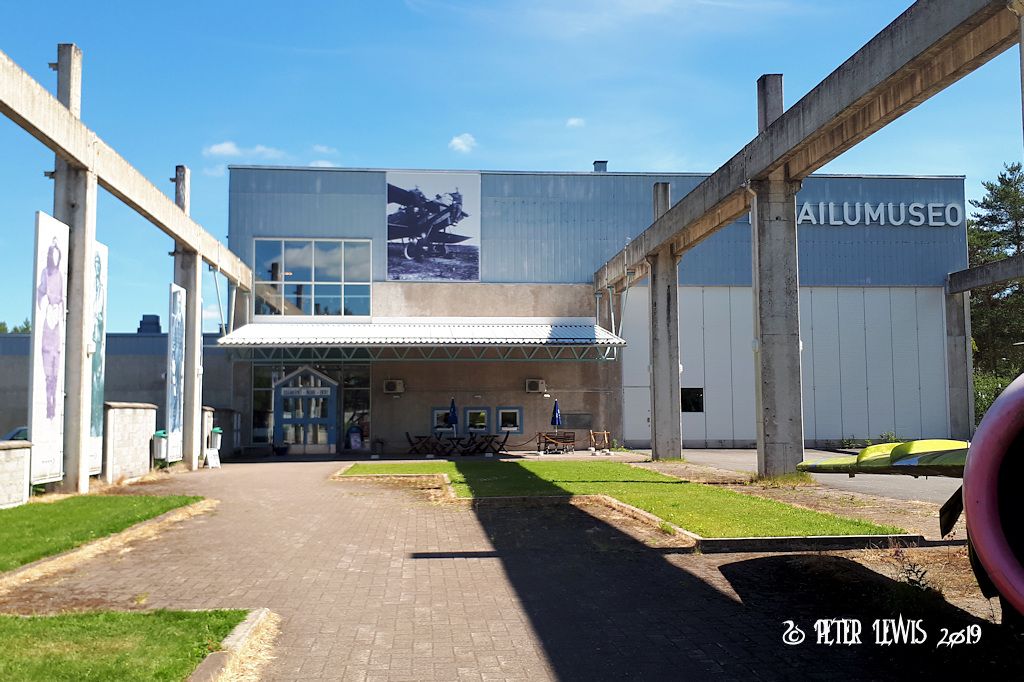 alongside that entrance sits a garishly painted PZL Lim-5 (Polish-built version of the Mig-17) 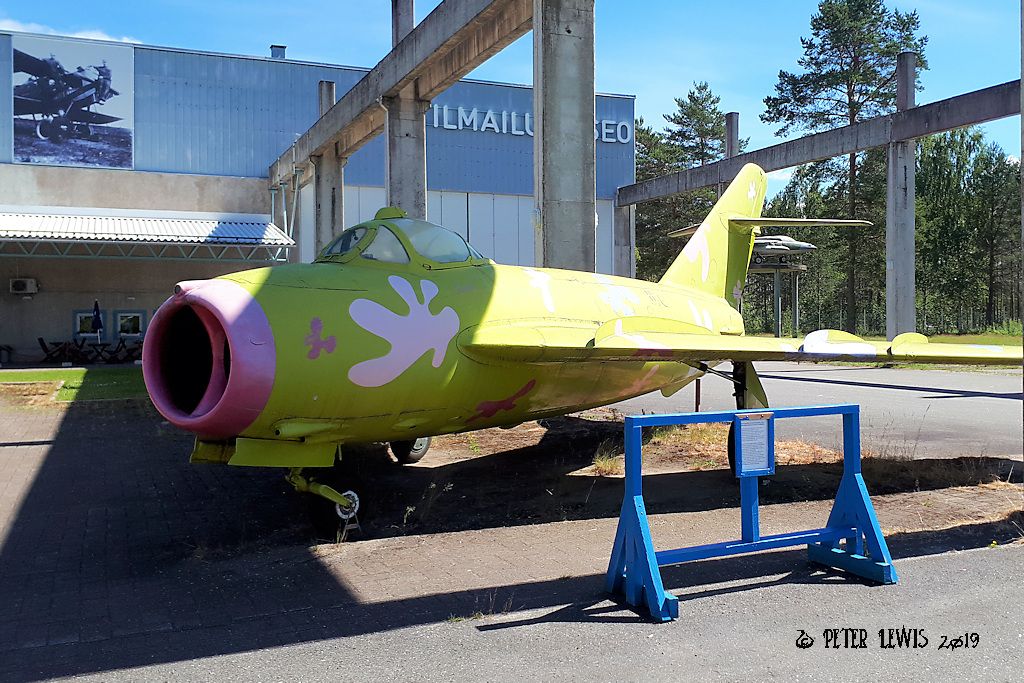
After presenting myself at the entrance and paying my 10euro entry fee I was able to enter and view.
Like most such museums, the exhibits are fairly crowded, but there are upper-level viewing gantries which does help
More to come |
|
|
|
Post by johnnyfalcon on Aug 29, 2019 7:05:03 GMT 12
Great story-telling Peter! I'm looking forward to the next instalment
|
|
|
|
Post by Peter Lewis on Aug 29, 2019 18:04:16 GMT 12
The first aircraft of the Finnish Air Force was the Swedish produced two-seater NAB Type 9 Albatros, which was a licensed copy of the German Albatros B.II. This was bought using collected funds of the Swedish-based Friends of Finland Association in February 1918. However, its ferry flight to Vaasa was cut short at Pietarsaari by engine failure. Presumably, it got no further. On the 6th March 1918 a Thulin Type D reconnaissance aircraft (modified Morane-Saulnier Type L built under licence in Sweden), landed at Vaasa with pilot Lieutenant Nils Kindberg and as a passenger the plane’s donor, Count Eric von Rosen. Finnish commander-in-chief Mannerheim’s Order of the Day called it ‘Airplane Number 1’ and so it was marked as F.1 to signify it as the first official aircraft of an Independent Finland Air Force. The Thulin had the Count’s personal good luck charm painted upon it, a Blue Swastika. Thus that symbol was adopted as the official marking of the Finnish Air Force. There are two Thulin replicas on display at the museum. The first one, right as you enter the door, is just a bare fuselage to show the construction methods 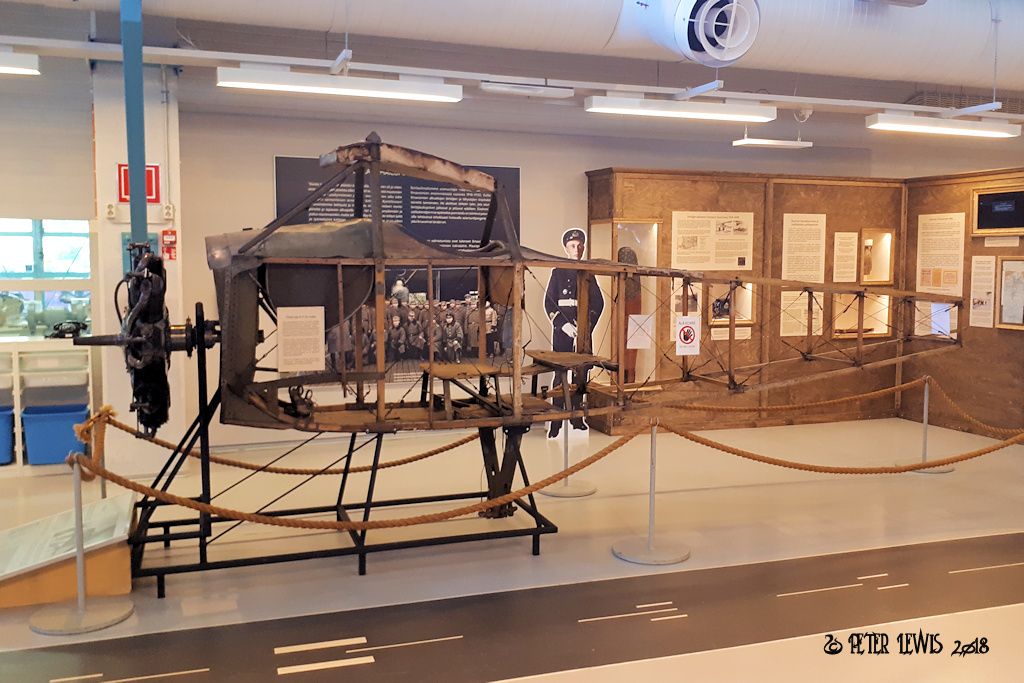 Floating above and suspended from the rafter is the second one. This has been completed with the original markings, and is shown dropping propaganda leaflets. This was one of the duties this aircraft performed during the Finnish Civil War of 1918-19 that saw Finland become independent from Russia.
|
|
|
|
Post by FlyingKiwi on Aug 29, 2019 19:50:10 GMT 12
I'll enjoy seeing these photos. There can't be many air forces that can have such an eclectic collection of aircraft on display that legitimately served in their ranks - I think during WWII alone they operated British, American, German, French, Russian, Italian and domestically produced aircraft and probably more?
|
|
|
|
Post by Peter Lewis on Aug 30, 2019 11:22:17 GMT 12
In 1917 the the Martinsyde F.3, a single-seat biplane fighter powered by a Rolls-Royce Falcon V-12 engine, appeared. Although a sound and attractive design, it was obvious that all Falcon production was required to power the Bristol Fighter so use of the Falcon for the F.3 would be problematical. Martinsyde then redesigned the F.3 to be powered by the 300 hp Hispano-Suiza 8 engine, and result was the F.4 Buzzard. The prototype F.4 was tested in June 1918, and was found to be powerful, fast and maneuverable. Large orders were placed, with the intention of supplying the Buzzard to both the French Aéronautique Militaire as well as the Royal Air Force. Further production in the USA was also anticipated. In the great swirling air battles of 1919 the Buzzard would have been a strong opponent for the Fokker D.VII, but the Armistice intervened and so Martinsyde was instructed to only complete those aircraft which were part built, while all other orders were cancelled. The Buzzard was not adopted as a fighter by the post war RAF, the cheaper Sopwith Snipe being preferred despite its lower performance. The Martinsyde company diversified into motorcycle manufacture post-WW1, but a factory fire in 1922 spelled the end of the company. Remaining Buzzards passed into the hands of the Aircraft Disposal Company who sold one to the Finnish Air Force in 1923. They liked it, and bought 14 more in 1927. The last examples were withdrawn from service in 1939. The museums example is the only complete Martinsyde aircraft to survive world-wide. Coded MA-24, the serial D4326 has been associated with this airframe, which would have been the allotted RAF serial. The 150 Martinsydes from this batch ( D4211 to D4360 ) did not enter RAF service. 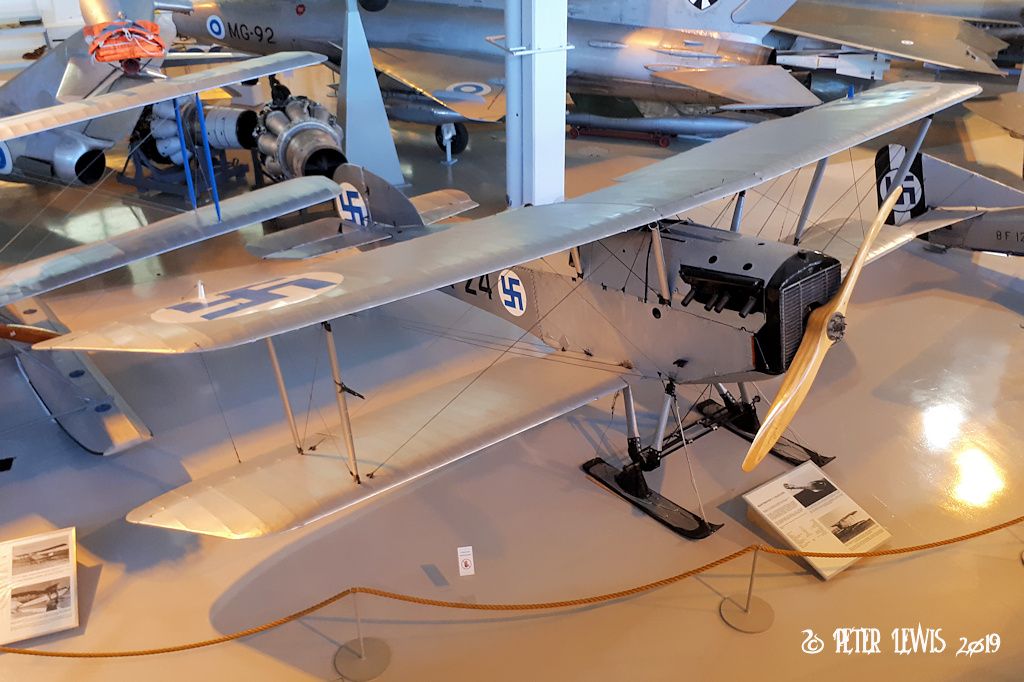 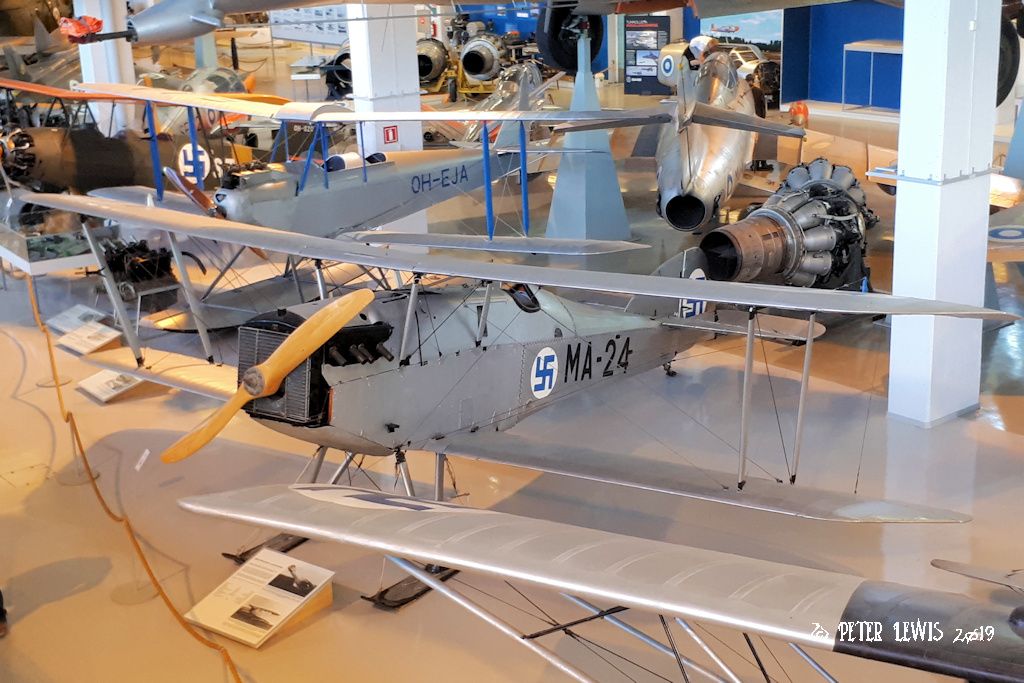 |
|
|
|
Post by Peter Lewis on Aug 31, 2019 19:49:05 GMT 12
The Bréguet 14 was a French biplane bomber and reconnaissance aircraft of the First World War. It was built in very large numbers and is considered to have been one of the best aircraft of that war. Production of various versions continued for many years post-war. Finland acquired twenty Bréguet 14 A2 aircraft and also over two hundred used Fiat A-12bis engines from French surplus stock. The first four aircraft arrived to Finland in July 1919. In 1921 ten more aircraft were bought, followed by eight next year. The airframes obtained in 1921 were without engines. The type formed the backbone of Finnish Aviation Forces during the mid-1920s and remained active in Finnish service until 1927 Apparently a new wing profile was tried on Bréguet 3C30 (ex French No. N1922) at some stage, but it worsened the flight characteristics so much that the Air Force did not accept the aircraft and it was taken out of service and stored after only 60 hours following a major overhaul. There is a photograph of this Bréguet serial 3C30 crashed at Utti around 1925-26 after an incident, with damaged upper and lower right wings. Around this time the aircraft was stored at Vesivehmaa until 10 May 2000 when it was moved to the museum for restoration and display. 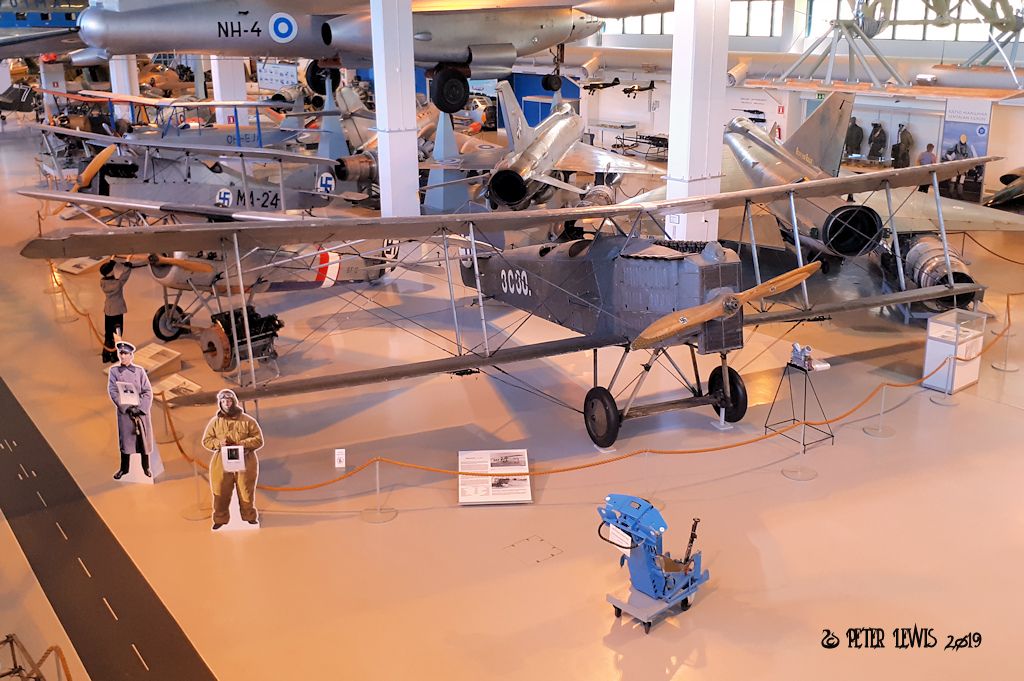 |
|
|
|
Post by Peter Lewis on Sept 2, 2019 18:16:42 GMT 12
In October 1922, the Finnish Military Headquarters sent a tender to the Dutch Fokker company, the French Gourdou & Leseurrelle company and the British Aircraft Disposal Company requesting one fighter each for comparison purposes. Bids were received and the evaluation aircraft, including a Gourdou-Leseurre GL.21, were ordered in January 1923. After trials the Gourdou-Leseurre was selected and 18 GL-22 machines were purchased (allowing some for spares) and thse aircraft arrived in Finland in the summer of 1924. The Gourdou-Leseurre GL.2 was a French fighter aircraft which made its maiden flight in 1918. The GL.2 had shown pleasing performance during testing but which had been ultimately rejected by the Aéronautique Militaire due to concerns about the rigidity of the wing. An improved version, designated GL.21, featured not only a new wing design, and also a revised fin and rudder for improved directional stability, and strengthened undercarriage, but the end of the war meant a loss of French official interest. Gourdou-Leseurre continued development anyway, and by 1920 had an improved version, designated GL.21 ready for exhibition at the Paris Salon de l'Aéronautique that year. This differed from the GL.2 mostly in having revised ailerons and a batch of twenty were purchased by the Aéronautique Militaire, plus the one being purchased by Finland for evaluation. Development of the design continued with the GL.22. This featured a redesigned wing of greater span, and modified horizontal stabiliser and landing gear. This proved to be a moderate success for Gourdou-Leseurre, selling 20 to the Aéronautique Maritime as the GL.22C.1, as well as 18 to Finland, 15 to Czechoslovakia, 15 to Estonia, and one to each Latvia, and Yugoslavia. An additional example was later assembled in Finland from spare parts. The Gourdou-Leseurre aircraft remained in Finnish military service until 1931 when they were apparently wihdrawn due to due to metal fatigue. 8F.12 is the only know survivor from this manufacturer, who closed down in 1934.  |
|
|
|
Post by Peter Lewis on Sept 3, 2019 19:54:25 GMT 12
The de Havilland Aircraft Company developed the light two-seat DH60 Moth for flying clubs and private owners. The maiden flight was February 22nd 1925. The aircraft was the most popular light aircraft in Europe during the 1930s. The production of enhanced DH60X version started in 1927. The 60X featured the optional 'X' braced undercarriage version of the early Gipsy Moth. The Finnish State Aircraft Factory acquired the manufacturing license of the Moth in 1928. It built 21 Moths in 1929-1930 and 18 of them delivered to the Finnish Air Force for use as trainers, replacing earlier Caudrons. Twenty three Moths served with the Finnish AF from 1929 to 1944. DH60X Moth MO-105 c/n VL10 was completed at the State Aircraft Factory in 1929. MO-105 was civilianised and allotted registration K-SILC in June 1931. Flown as OH-ILC and owned by the Vyborg Air Defense Association, the aircraft was severely damaged in 1933. Later registered as OH-MAH in January 1934 and then in June 1947 became OH-EJA. Private owners were Viipurin Ilmapuolustusyhdistys, Viipuri, named 'Karjala' then M.Hannula, Ruotsinpyhtaa, named 'Pitkaisen Poika' and finally E.Juurikas, Kuorevesi named 'Jurre'. The floats currently fitted were designed and built in Finland by the Karhumaki brothers. OH-EJA was finally withdrawn from service in June 1957. The museum is also said to house UK-built Moth K-SALF / K-SILA / OH-ILA c/n 499 WFU 1937, but (along with the sole FAF Avro 504) it must be stored away out of sight in a cupboard somewhere. The linguistic barrier effectively prevented any research on its whereabouts. 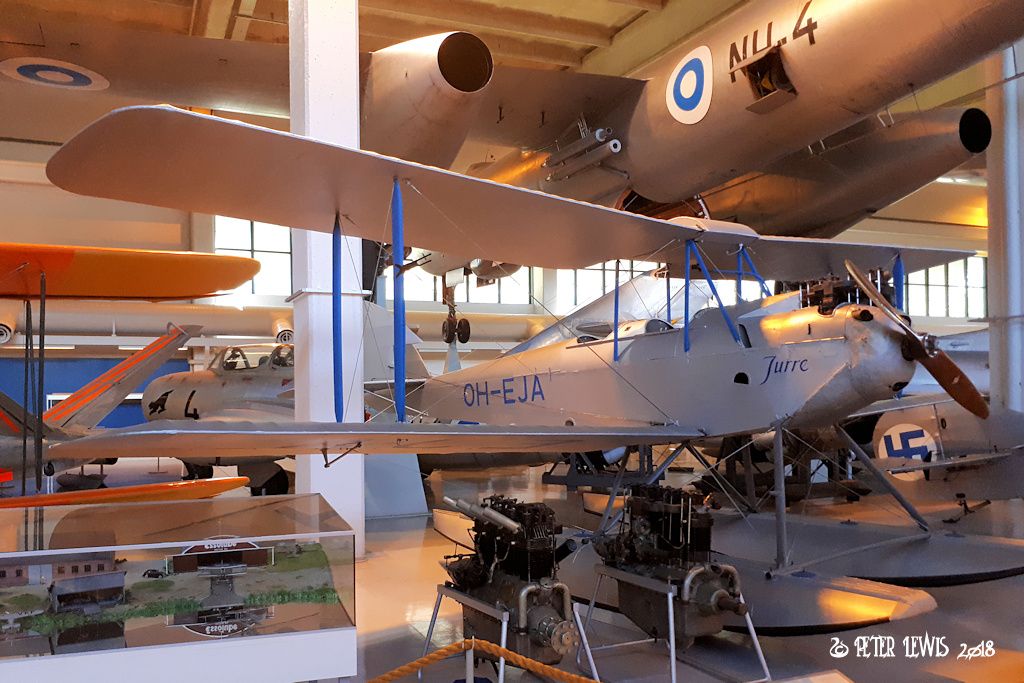 |
|
|
|
Post by Peter Lewis on Sept 4, 2019 20:19:36 GMT 12
The Fokker D.XXI was initially developed in response to a request from the Royal Netherlands Indies Army (KNIL) for a rugged and easily maintained fighter aircraft. The design represented a complete breakaway from previous Fokker biplane and high-wing monoplane designs, being a low-wing monoplane with fixed, spatted landing gear. The Netherlands army air division contracted for a prototype in 1935 to evaluate the type's potential for use in the Netherlands East Indies, and the prototype first flew on 27 February 1936 at Eindhoven with a 645 hp Bristol Mercury VI-S radial with Fokker test pilot Emil Meinecke at the controls. At this time the Netherlands government was inclined more towards bombers than fighters for home use, but a change in policy in the summer of 1937 led to an order for 36 D.XXIs to be powered by Bristol Mercury VII or VIII radial engines. In the same year seven Mercury VIII powered D.XXIs were ordered for the Finnish air force, and a licensed production arrangement was concluded under which the Finnish State Aircraft Factory at Tampere built 93 D.XXIs between 1938 and 1944. Of these, the first 38 Mercury-powered aircraft were completed by 1938, but a further 50 built in 1941 were modified to take the 825 hp Pratt & Whitney Twin Wasp Junior SB4-C/-G engine, 80 of which had been bought in 1940. Finnish D.XXIs had all four guns mounted in the wings, instead of two in the fuselage and two in the wings. A final batch of five Bristol Pegasus-powered D.XXIs appeared in 1944. When Finland terminated the Winter War on 12 March 1940, 29 D.XXIs were still on strength. It was decided subsequently to build another 50 aircraft, so the Finnish air force had a number available when hostilities with the USSR restarted in June 1941. The Fokker D.XXI performed well in the Finnish Air Force. Against the aircraft of the Soviet Air Force, the Fokker was evenly matched, and its rugged design with a radial engine and fixed undercarriage made it very suitable for Finnish conditions. Later in the war, as newer models of Soviet fighters appeared, the Fokker D.XXI was underpowered and too lightly armed (with only four 7.92 mm/.312 in machine guns) to compete. Some of the D.XXIs began to be replaced by the relatively unsuccessful IVL Myrsky in August that year, although a few lingered on long after the end of the war. The Finnish Air Force had 97 of the 145 Fokker D.XXI aircraft completed in addition to the prototype. In the Winter War, Fokker D.XXI formed the backbone of Finnish fighter defense. The aircraft type achieved 141 aerial victories in the Winter War and a further 60 in the Continuation War. The aircraft type was used at the Air War School until September 13, 1948. Most of the Finnish D.XXIs operated with 'snowshoe' landing gear during the winter. One Twin Wasp-powered aircraft was modified to have retractable landing gear, but its performance was not improved sufficiently to warrant conversion of the other in-service aircraft. Several Finnish Air Force pilots became fighter aces with the Fokker D.XXI. The top scoring Fokker ace was Jorma Sarvanto who obtained 12 5/6 victories with the type. Many other future aces scored at least one victory with the Fokker. The highest scoring airframe was FR-110, with 10 victories. This aircraft survived the war and is the one on display here.
|
|
|
|
Post by Peter Lewis on Sept 5, 2019 18:00:28 GMT 12
The Bristol Blenheim light bomber was used extensively by the Finnish Air Force throughout the Second World War. The first short-nosed Mk. I production aircraft entered RAF service in March 1937. A total of 5300 Blenheims were built in a number of different versions. The aircraft was built under licence by overseas countries, including Finland and Yugoslavia, which completed 16 aircraft with a further 24 in advanced stages of completion when Germany invaded their country. The Finnish Air Force had already started to prepare the purchase of Blenheims during the type's design stage. The first aircraft arrived to Finland on 29th July, 1937. The air force had a total of 97 Blenheims of which 22 were long-nosed Mk.lVs. There were 55 Finnish licence-built Blenheims, of which 10 were Mk. IVs, the final aircraft being completed in September 1944. These aircraft, including BL-200 on display, were mainly assembled from Yugoslavian-made parts which were bought from Germany. The Blenheim was the most important bomber type of the Finnish Air Force during WWII. The Finnish Blenheims flew 423 missions during the Winter War, and close to 3,000 missions during the Continuation War and Lapland War. Blenheim machine-gunners also shot down eight Soviet aircraft. Thirty-seven Blenheims were lost in combat during these conflicts. In addition to bombing, it was also widely used for photo reconnaissance. The Blenheim Mk.IV was one of the fastest bombers of the FiAF. Drawbacks were inadequate defensive armament and small bomb load. The air force used Blenheims in 1950s on photo- and target towing duties. Last flight of type in Finland took place on 20May1958 by BL-199. BL-200 was built by the State Aircraft Factory, Tampere, Finland. First flight 21March1944, Last flight 5June1957, at 885hrs 15 min airframe flight hours and is the only complete surviving genuine Blenheim in the world. Other surviving Blenheims are converted Bristol Bolingbrokes. Its last role was that of an aerial survey photographic aircraft. 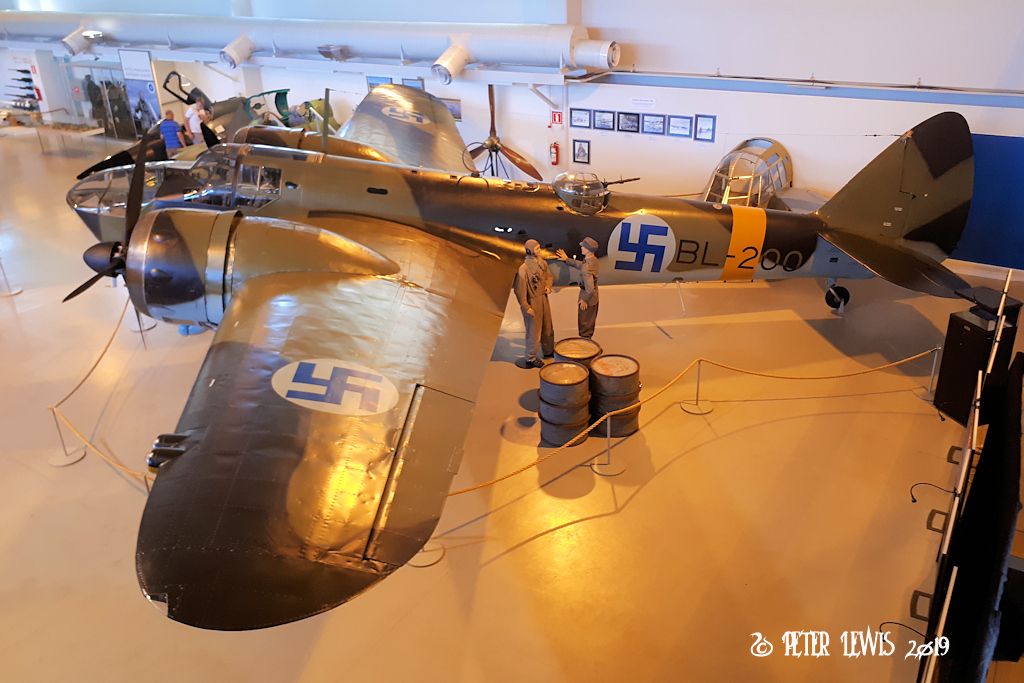 Adjacent is an incomplete Blenheim cockpit section. The museum states that this item was a factory spare, and never fitted to an actual aircraft. 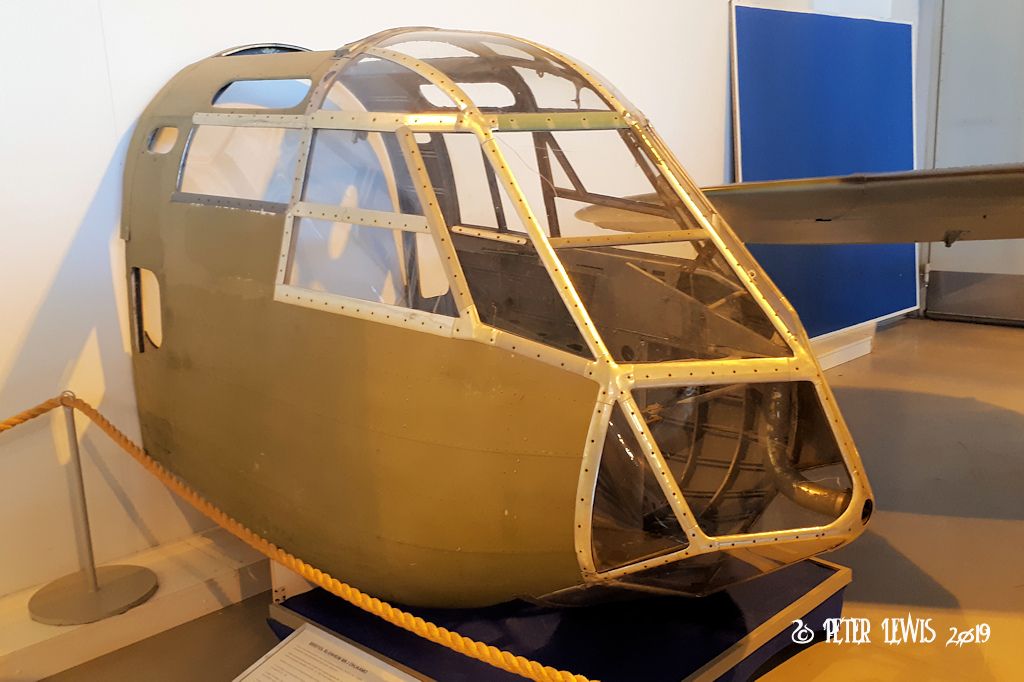 |
|
|
|
Post by Peter Lewis on Sept 6, 2019 18:02:32 GMT 12
The Focke-Wulf Fw 44 Stieglitz is a German single-engine, two-seater trainer and aerobatic aircraft designed by the famous Kurt Tank. The aircraft was first flown in 1932 and found widespread popularity as both a private owners aircraft and as a military trainer. In addition to the German Luftwaffe, the FW-44 was used by the air forces of Argentina, Bolivia, Brazil, Bulgaria, Chile, Austria, China, Colombia, Romania, Sweden, Slovakia, Finland, Czechoslovakia and Hungary. Danish sympathizers collected money during the Winter War of 1939 - 1940 in order to train Finnish pilots in Southern Sweden. Before the ceasefire the Finnish Air Force decided to purchase their own training aircraft and equip a military flying school in Finland. The procurement proceeded during and after the Winter War in collaboration with the Swedish Air Force. The contract for 30 Focke-Wulf Fw 44J Stieglitz was signed on 11April1940 and one sales incentive was apparently the shortage of foreign currency in Germany. The aircraft were flown from Warnemünde to Finland between May 25th and August 15th 1940. Five additional aircraft were bought in 1944. The Stieglitz were used as trainers at Kauhava until 1960, when the surviving 15 aircraft were sold on to the civilian market. Some survivors from this sale are still active today. In 1970 the Finnish Air Force bought SZ-4 back and it was used at the Testing Flight until 1989 when it was handed over to the the museum. SZ-4 had arrived in Finland as D-EXWK, and after its military service flew in civilian guise from 1960 as OH-SZO. 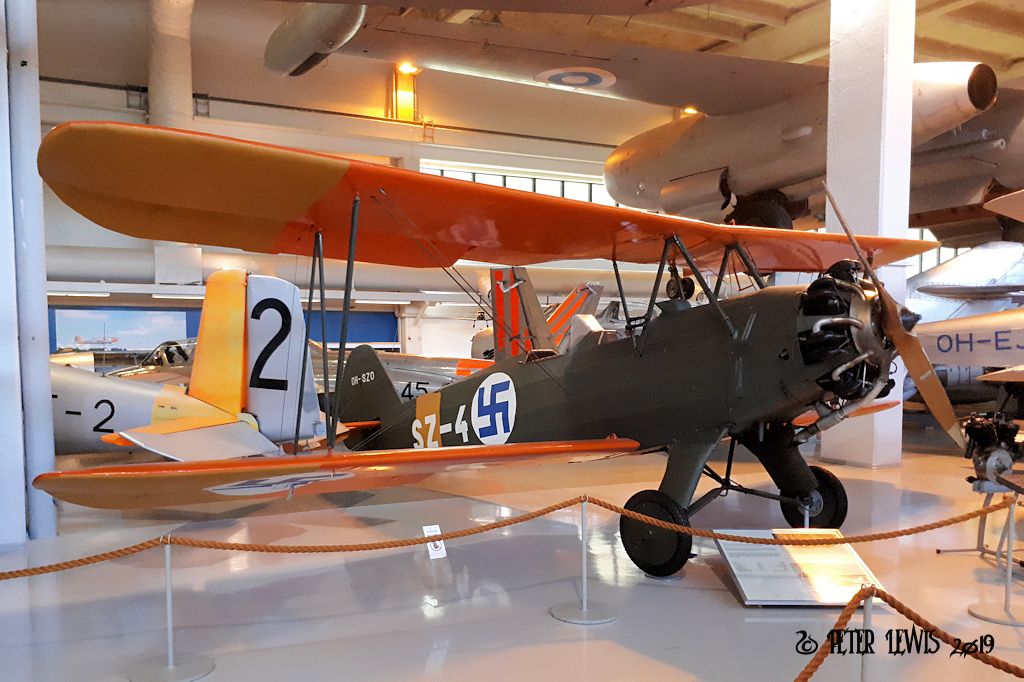 |
|
|
|
Post by Peter Lewis on Sept 7, 2019 18:01:41 GMT 12
During the 1940 Winter War Britain sold Finland twelve Hawker Hurricane Is. The aircraft were flown over the North Sea from Scotland to Norway and then to Finland. Two were lost during the ferry flight, and the rest arrived in Finland between March 7 and 10, 1940. The Hurricanes arrived too late to participate in the Winter War. The lack of spares to service the machines saw the number remaining operational reduce to five during the Continuation War. Five of the original Hurricanes were destroyed in battle and two from anti-aircraft fire, with four pilots losing their lives. Only 5½ kills were achieved with Hurricanes. The last few Hurricanes Is were stored in May 1943 due to lack of spare parts. Hurricane LF.Ia HC-452 c/n: 41H/11096 ex-RAF N2394, in which 2nd Lt. Resko Ruotsila scored 2½ victories, survived The aircraft is one of the oldest Hawker Hurricane I in the world. This Hurricane was accepted by the RAF in 1939, and was assigned to the Finns on 21February1940. Ferry Flight: 25 February 1940 Finland (Pilot: Ensign Nissinen). Assigned: May 1940, LeLv 28 (markings: 5) (HC-452) (Turku AB). Assigned: 30August1940 LeLv 30; Assigned: 23June1942 LeLv 28; Assigned: LeLv 26, damaged 17July1942 (Immola AB); SOC: 16July1944 (Parola AB). Assigned: 1969 Finnish AF Museum HC-452 logged only a total of 208 hours and 15 minutes of flight time in the service of the Finnish Air Force. The final flight of this warbird took place in July 1943. According to archive data the aircraft was first transferred from Flying Squadron 26 to Parola airfield between July 24-26 1943. At the time a thorough handover document was written which listed missing parts and pieces from the plane. The aircraft was finally written off from Air Force inventory in August 1944. During the final phases of the war all valuable equipment was stripped away from the Hurricane for later use. During late Summer 1944 an engineering survey checked the HC-452 and decided that it was in too bad condition and thus no more repairs were to be done. That survey also recommended that the aircraft was to be scrapped in the immediate future. After the war the Hurricane was stored away at Vesivehmaa airfield. It was placed in an old aircraft hangar. The Hurricane remained there until the late 1970’s. During that time people were able to take parts from the Hurricane as “souvenirs”. There are some wild stories connected to the Hurricane. According to one the original Merlin engine was still connected to the aircraft during the 1950’s but ultimately the engine was lost because someone borrowed it to an agricultural exhibition which organizers never sent it back ! The story of the HC-452 continued in the late 70’s when the Aviation Museum of Central Finland was created at Jyväskylä Tikkakoski area to preserve and collect the history and traditions of the Finnish Air Force. The HC-452 was placed in the permanent exhibition at the Luonetjärvi airfield’s old number one hangar where the museum was first located. During the Continuation War Finland gained three damaged Soviet Hurricane IIs and one of them was repaired to flying condition. Hurricane Mk. IIA Z2585 flew with Nos. 56 and 316 (Polish) squadrons, RAF, before it was shipped to Russia and assigned to the 152nd Fighter Aviation Regiment (IAP). During a reconnaissance flight on 16Feb1942 Lieutenant Feodor G. Zadorozhny suffered engine failure, force-landed on Lake Tuoppajärvi. He made his way back to Soviet territory. Soviet aircraft strafed the plane two days later, putting 25 bullet holes in it, but the Finns recovered it. Their State Aircraft Factory replaced its engine and eight-gun wings with the engine and 12-gun wings of Z3577, a Hurricane IIB of the 769th IAP that had been downed on April 6, along with a de Havilland propeller salvaged from one of the Mark Is and flew it as HC-465. By the time HC-465 became operational, the Finns had retired their Hurricanes Is from first-line service. It was used as a trainer and target tug at Kotka from 16Mar1944 through 31May1944, then grounded and eventually scrapped. A Canadian built Mk XIIb ( the Canadians referred to them as Mk 12′s whereas in the UK they were designated as Mk IIb ), Royal Canadian Air Force number 5487, was built by the Canadian Car and Foundry company in mid 1941. Issued to 127 Squadron for coastal defence it crashed in November 1942 and the remains were recovered and shipped to the UK in 1990. Returning to the air in 2015 as G-CBOE, the Hurricane completed its flight testing before being painted into a temporary Finnish scheme as HC-465 for an airshow appearance in Finland in August 2014. On return from these special duties the airframe had the temporary scheme removed revealing an all over silver Rhodesian scheme. G-CBOE has since been sold to an owner in Germany.
|
|
|
|
Post by Peter Lewis on Sept 7, 2019 19:26:37 GMT 12
There will now be a break of a few days while I follow up on John Cleese's "Visitors Guide to Palmerston North".
|
|
|
|
Post by johnnyfalcon on Sept 8, 2019 10:04:18 GMT 12
Nice one Peter. There are some real gems there (the museum...)
|
|
|
|
Post by FlyingKiwi on Sept 8, 2019 13:14:59 GMT 12
That would be a really good modeller's reference with the open panels.
|
|
|
|
Post by Peter Lewis on Sept 12, 2019 18:02:29 GMT 12
The Brewster F2A Buffalo was an American fighter which saw service early in World War II. Designed and built by the Brewster Aeronautical Corporation, it was one of the first U.S. monoplanes and was initially fitted with an arrestor hook and other modifications for aircraft carriers. Several nations, including Finland, Belgium, Britain and the Netherlands, ordered the Buffalo. The Finns were the most successful with their Buffalos, flying them in combat against early Soviet fighters with excellent results. On 16Dec1939 the Finnish government signed a contract to purchase 44 aircraft: a F2A-1 variant designated Model B-239E by Brewster. These were acquired despite the U.S. law which prohibited the sale of war material to combatant countries. The loophole which permitted the acquisition of the Brewster 239s was a clause in the law which permitted the sale of 'rejected' equipment. It was 'arranged' that the U.S. Navy rejected 44 Brewster Buffaloes which were then sold to Finland at a nominal price. Unit price was US$54 000 per aircraft plus packing and delivery costs. The purchase included 10 spare engines, 20 propellers and other spare parts, all purchased for a total sale price of 3.4 million dollars.
The B-239E was built with a more powerful engine than the F2A-1 in the form of the Wright R-1820-G5 producing 950 hp and the capacity to carry four machine guns rather than the two carried by the F2A-1. The B-239E was also "de-navalized" before shipment: equipment such as tailhooks and life raft containers were removed.The upgraded engine and slightly reduced net weight from the omitted armor and de-navalization resulted in an improved power-to-weight ratio and better general performance. Four batches of B-239Es were shipped initially from the New York City Brewster factory to Bergen, in Norway during January and February 1940. The crated fighters were then sent by railway to Sweden and assembled by SAAB at Trollhättan, northeast of Gothenburg. None of the B-239E fighters saw combat in the Winter War of 1939–1940. However, five of the six delivered during the war did become combat-ready before it ended. During the Continuation War of 1941 - 1944 the Buffalos proved capable of engaging and destroying most types of Soviet fighter aircraft operating against Finland at that time. Lentolaivue 24 (Fighter Squadron 24) was equipped with the B-239s until May 1944, when the Buffalos were transferred to Hävittäjälentolaivue 26 (Fighter Squadron 26). Most of the pilots of Lentolaivue 24 were Winter War combat veterans. This squadron claimed a total of 459 Soviet aircraft kills with B-239s, producing 36 Buffalo "aces" while losing just 15 Buffalos in combat. From 1943, Finland's air force received Messerschmitt Bf-109Gs from Germany, and this much-superior fighter re-equipped most Finnish Air Force fighter squadrons. Five B-239s continued to fly until 1948, with last flights of Buffalos by the Finnish Air Force on 14 September 1948, after which they were stored until scrapped in 1953. The B-239E was never referred to as the name Buffalo in Finland; it was known simply as the Brewster, or by the nicknames Taivaan helmi ("Sky Pearl") or Pohjoisten taivaiden helmi ("Pearl of the Northern Skies"). On 25th of June, 1942 BW-372 flown by lieutenant Lauri Pekuri as part of a group of eight Buffalos met ten Soviet Hurricane fighters at Segozero Lake. In the fight seven Soviet planes were damaged. Lieutenant Pekuri shot down two Hurricanes (he had to his credit 18 shot down planes in total – 7 Hurricane in all) but his aircraft was heavily damaged during the combat. He tried to land the burning BW-372 onto Big Kolejärvi lake. The fighter turned nosed over on its cowl at high speed and sank. Lieutenant Pekuri succeeded in getting out from the cockpit and walked about 20 km to the battle-front, passing across a mine field to join his front-line units. In June 1944 Pekuri was shot down again and he remained POW for half a year. In the 1950's Pekuri became famous as the first Finnish pilot claimed to fly supersonic with a Folland Gnat (was this possible?) He passed away in August 1999. The Brewster was salvaged from the bottom of the lake in September 1998. The salvors smuggled the plane out of Russia and concealed it in Ireland while they tried to find a buyer; the buyers, meanwhile, fretted about the ownership trail. Eventually, in August 2004, BW-372 was acquired by the Museum of Naval Aviation in Pensacola, Florida, who planned to restore the aircraft and put it on display in its Finnish Air Force colours. These plans were put on hold when the museum was damaged in a weather event. Finally, ten years after she was pulled from that Russian lake, BW-372 went home to Finland apparently on loan to celebrate the 90th anniversary of the Finnish Air Force and is now on display at the Museum in unrestored condition. |
|
|
|
Post by FlyingKiwi on Sept 12, 2019 19:36:56 GMT 12
Now that's the one I wanted to see. The Buffalo is second only to the Defiant on my dream list of highly improbable flying restorations. Both of which by all accounts were nice enough to fly, just rather inadequate for the task set for them.
|
|
|
|
Post by Dave Homewood on Sept 12, 2019 23:58:42 GMT 12
I have spoken with six or seven pilots who flew the Buffalo. Only Geoff Fisken enjoyed flying them. The others did not like the type at all after converting from the much nicer SNJ's or Wirraways. All were glad to have survived the type and moved onto something else.
|
|
|
|
Post by vultee43 on Sept 13, 2019 0:17:47 GMT 12
Peter, apparently a Gnat will go supersonic in a dive.
|
|
|
|
Post by phasselgren on Sept 13, 2019 6:09:54 GMT 12
Now that's the one I wanted to see. The Buffalo is second only to the Defiant on my dream list of highly improbable flying restorations. Both of which by all accounts were nice enough to fly, just rather inadequate for the task set for them. seems a bit harsh  for a fighter with a kill to loss ratio of 15,5 to 1 in the Finnish Air Force. |
|








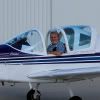


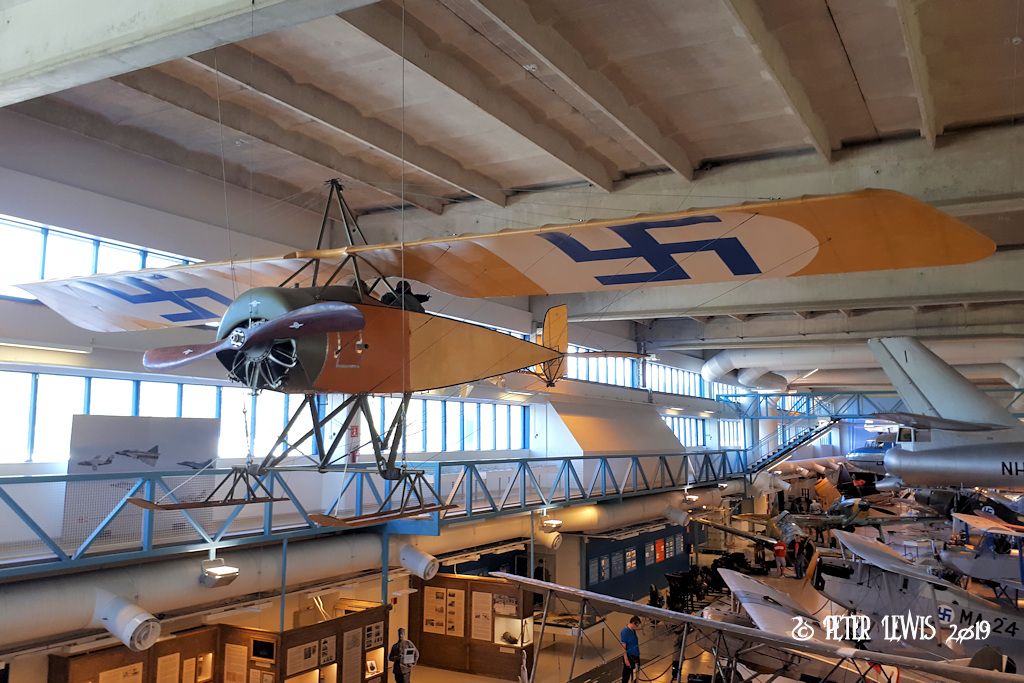






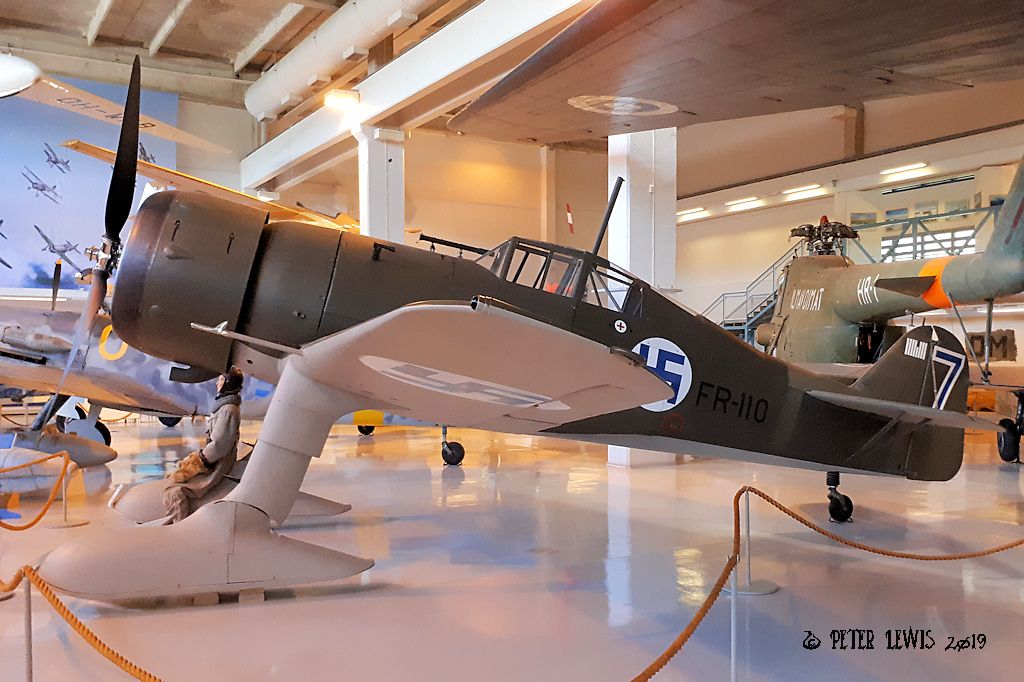



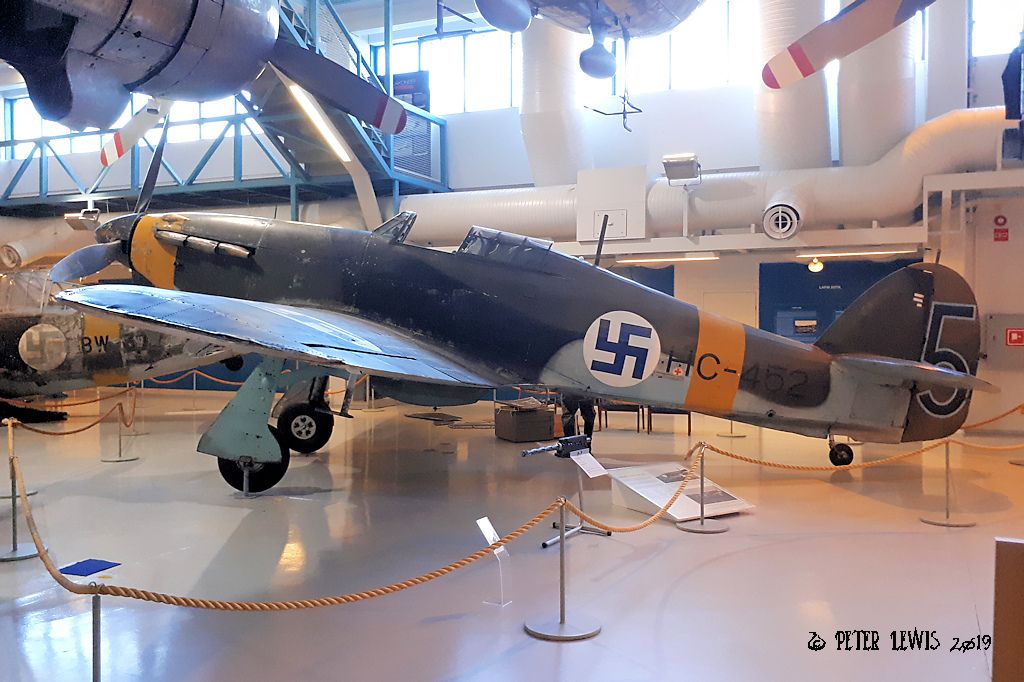
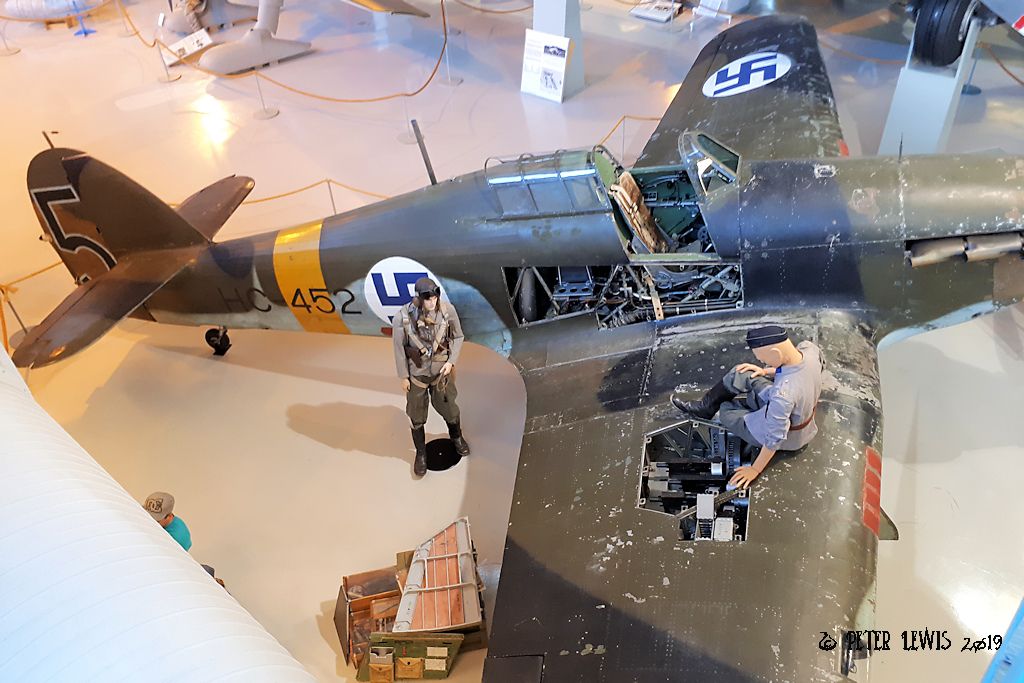
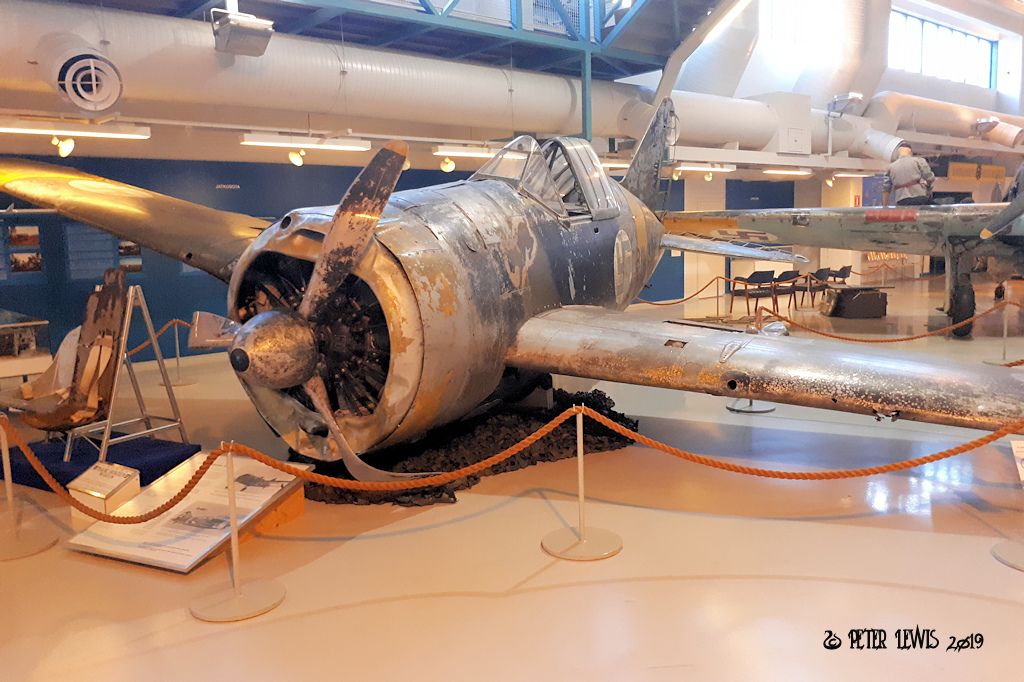




 for a fighter with a kill to loss ratio of 15,5 to 1 in the Finnish Air Force.
for a fighter with a kill to loss ratio of 15,5 to 1 in the Finnish Air Force.